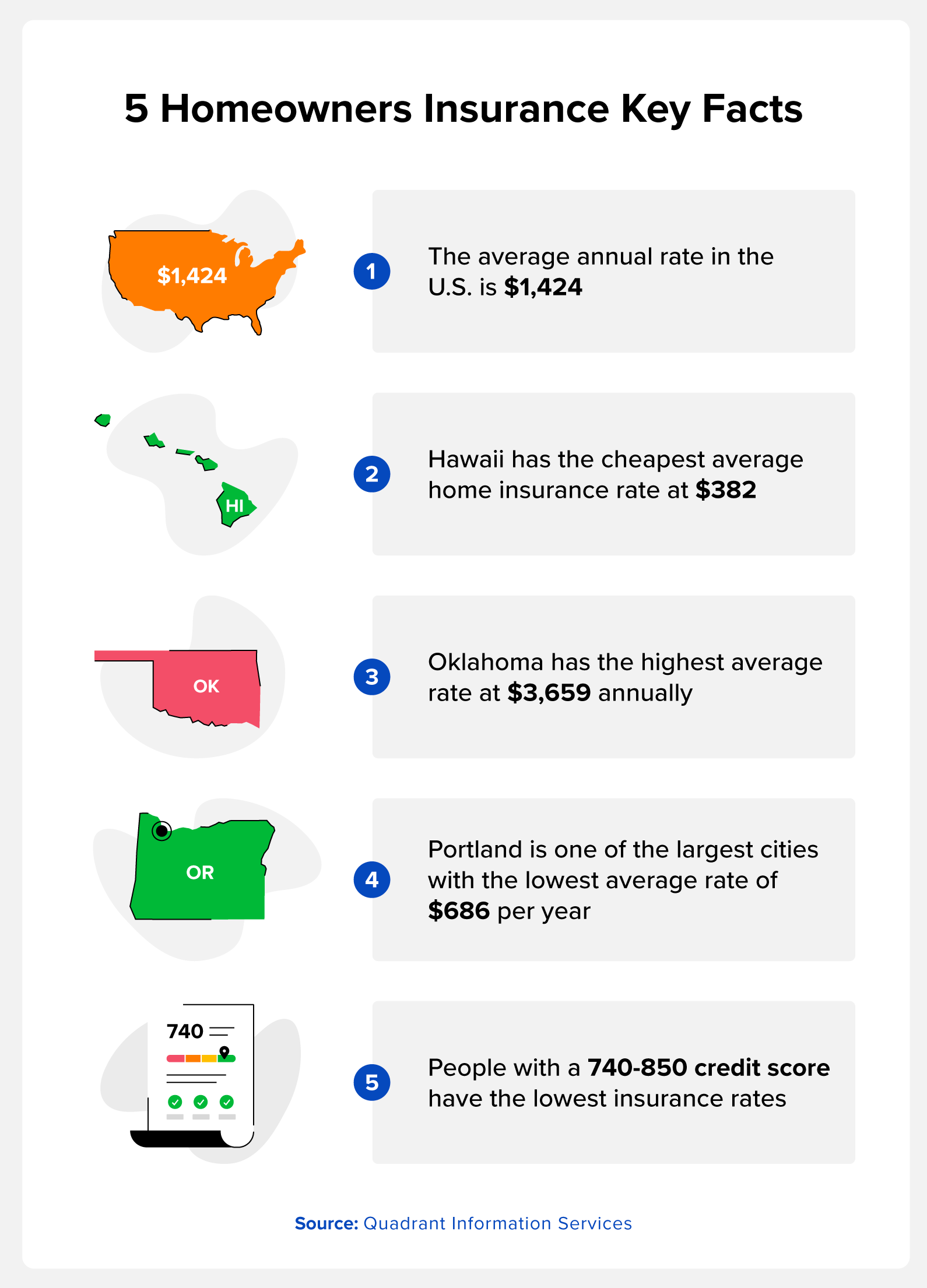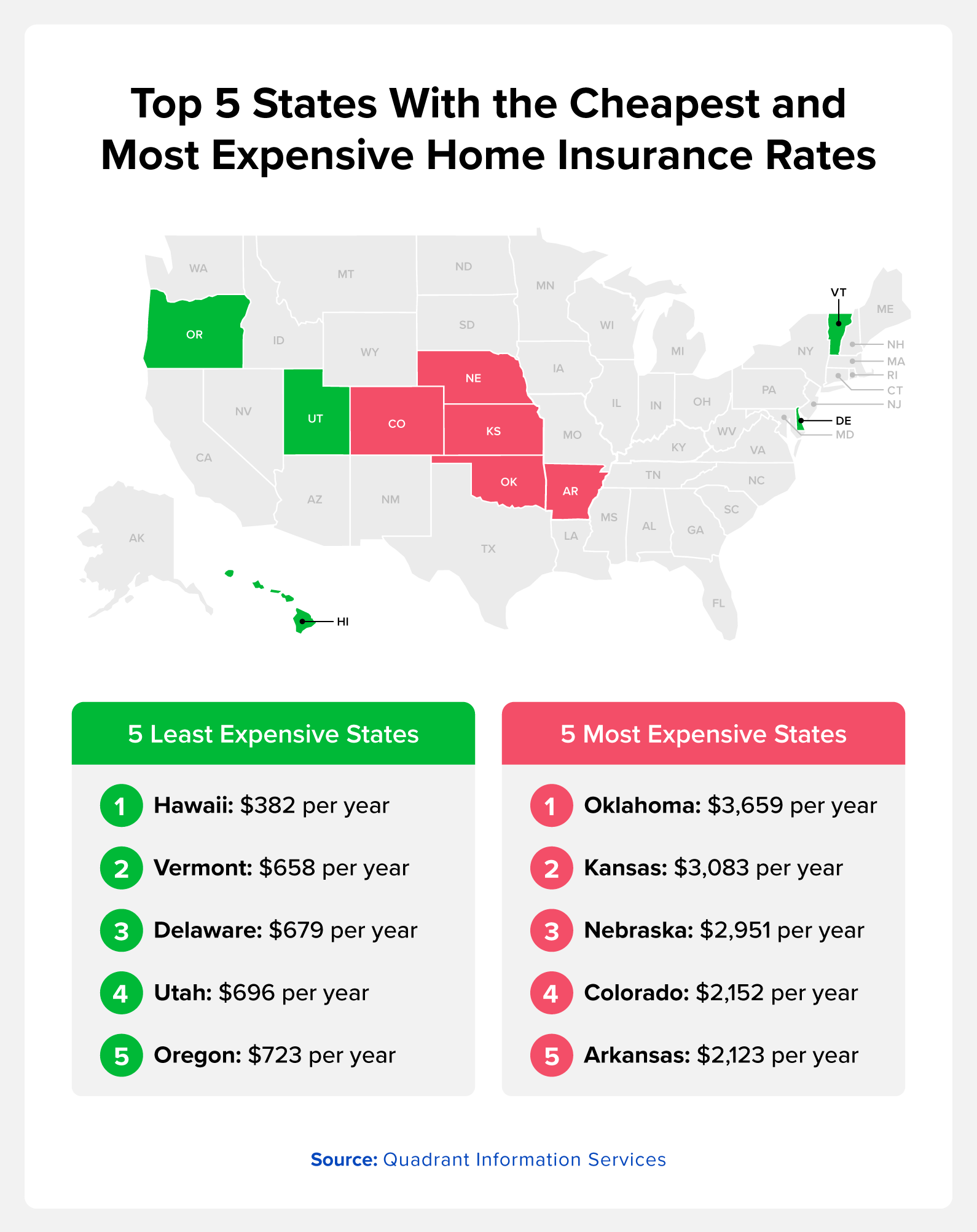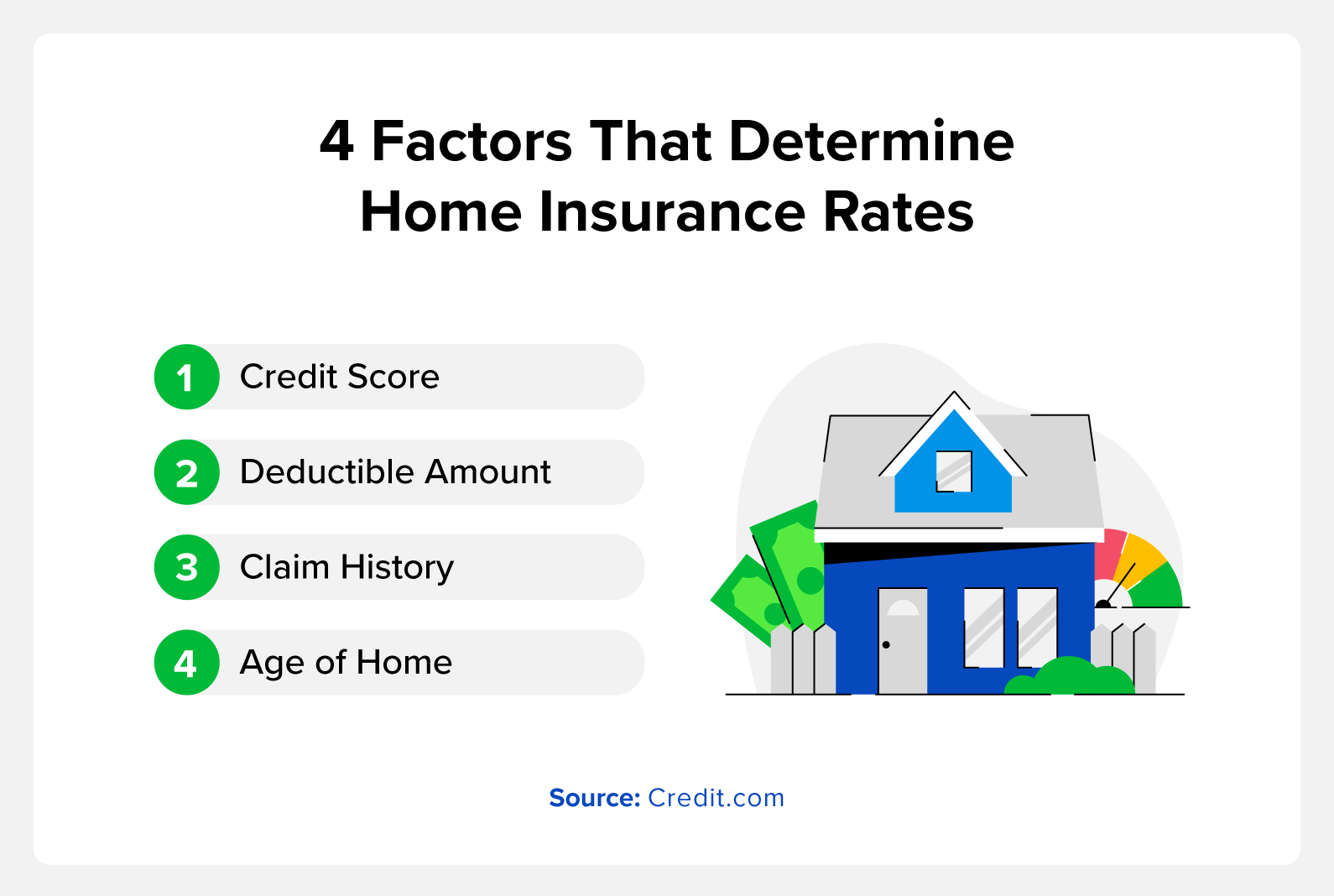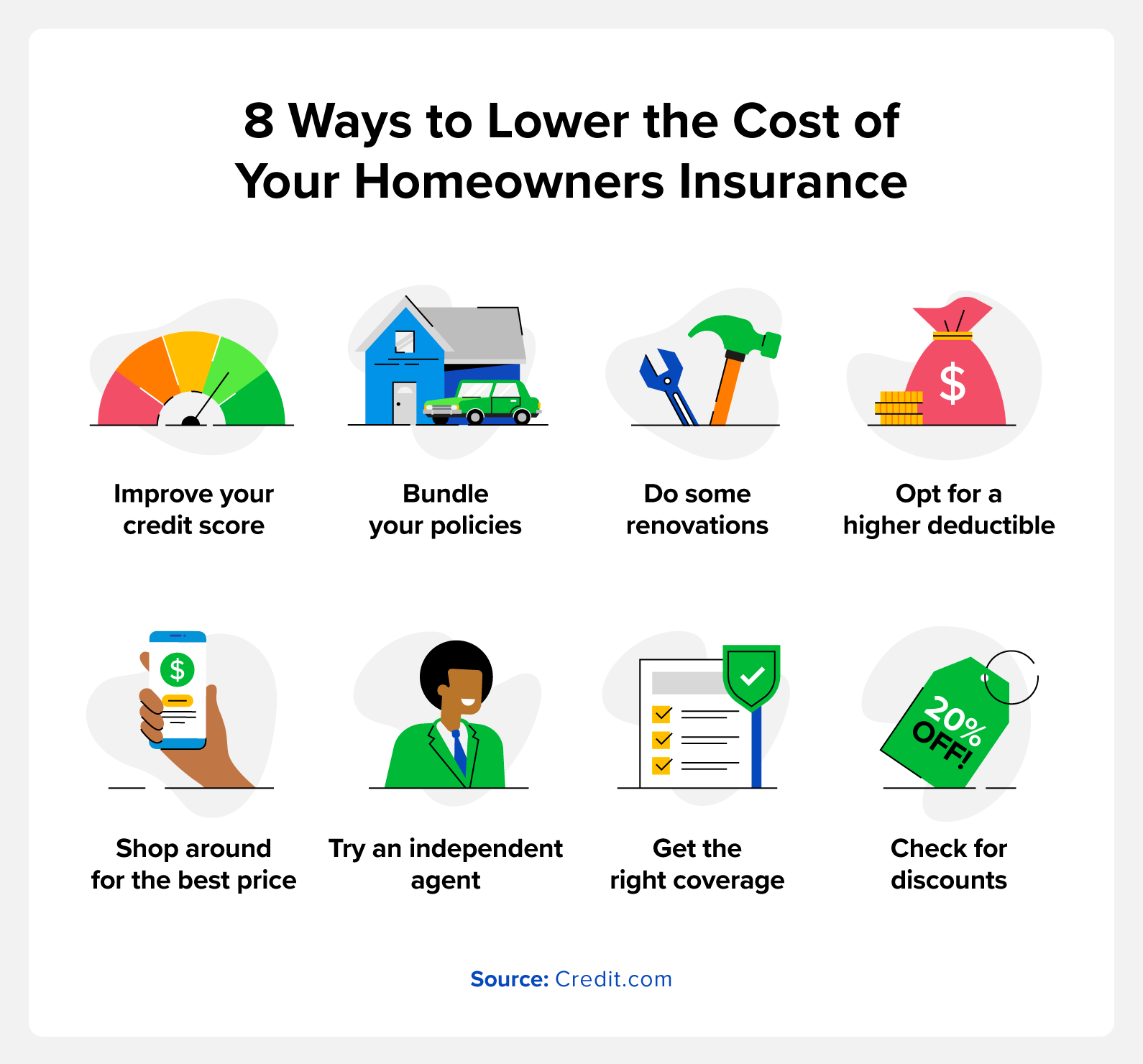
On average, homeowners insurance in the United States is $1,424 annually and about $118 per month. This price varies based on the state you live in, along with other factors like previous home insurance claims, credit score, and the age of your home.
If you’re buying a home, there are a lot of cost considerations, from the monthly closing costs to the mortgage payments and interest rate. One factor many people often overlook is the additional cost of home insurance. To properly budget for your new dream home, it’s helpful to know the average cost of home insurance in your state.
Today, we’ll go over the average insurance cost for each state, which companies have the best rates, and what factors can affect your rates. By learning more about home insurance, you can find the best deals to save money and enjoy the experience of moving into your new home. If you’re considering moving to a new state, this information may also help influence your decision.
Table of contents:
- Homeowners Insurance Facts
- Average Cost of Home Insurance by State
- How Much Does Homeowners Insurance Cost by Company?
- 4 Factors That Can Affect Homeowners Insurance Rates
- What Does Homeowners Insurance Cover?
- What Can Affect Homeowners Insurance?
- 8 Ways to Lower the Cost of Your Homeowners Insurance
Homeowners Insurance Facts
The cost of your homeowners insurance is affected by various factors. The cost of homeowners insurance can vary by state because some states are more prone to natural disasters than others. For example, Florida is more prone to hurricanes than other states, so the average cost is higher than in a state like Nevada.
As you’ll learn, homeowners insurance can range from less than $1,000 to over $3,000 per year. Here are some key facts about homeowners insurance in the United States:
- The average annual cost of homeowner’s insurance in the United States is $1,424.
- The state with the cheapest homeowners insurance at $382 per year is Hawaii.
- Oklahoma has the highest homeowners insurance rates, averaging $3,659 annually.
- Portland, Oregon, is the most populous city with the lowest average annual insurance rate at $686 per year.
- People with a credit score of 740 or higher have the lowest average insurance rates at roughly $1,207 per year.

Average Cost of Home Insurance by State
The overall average cost of home insurance in the United States is $1,424 annually or $118 per month.
The following chart and table show the average cost of home insurance for each state and includes Washington, D.C. These prices are based on $250,000 for dwelling coverage.
Texas
$1,967
0
0.5K
1K
1.5K
2K
2.5K
3K
3.5K
4K
Top 5 States With the Cheapest Homeowners Insurance Rates
Hawaii has the lowest annual rate of $382 per year, which is 73% lower than the national average. Vermont, Delaware, Utah, and Oregon are also in the top five states with the lowest homeowners insurance rates, and each is close to 50% lower or more than the national average.
- Hawaii: $382 per year
- Vermont: $658 per year
- Delaware: $679 per year
- Utah: $696 per year
- Oregon: $723 per year
Top 5 states With the Most Expensive Homeowners Insurance Rates
The states with the most expensive homeowners insurance rates in the country are Oklahoma and Kansas at $3,659 per year and $3,083 per year respectively. Some of the other states with the highest rates include Nebraska, Colorado, and Arkansas.
According to Insurance.com, these states have high rates because they’re more likely to experience tornadoes, hurricanes, hailstorms, and other natural disasters.
- Oklahoma: $3,659 per year
- Kansas: $3,083 per year
- Nebraska: $2,951 per year
- Colorado: $2,152 per year
- Arkansas: $2,123 per year

Average Cost of Homeowners Insurance by City
The city you live in may also determine the cost of your homeowners insurance rates. In addition to the possibility of natural disasters, population, crime statistics, and local materials and labor costs are also factors.
The following cities are the 25 largest cities in the United States, organized alphabetically. The table includes their average annual and monthly rates.
|
City |
Average Annual Rate |
Average Monthly Rate |
|---|---|---|
|
Austin, TX |
$1,715 |
$143 |
|
Baltimore, MD |
$1,224 |
$102 |
|
Charlotte, NC |
$1,256 |
$105 |
|
Chicago, IL |
$1,570 |
$31 |
|
Columbus, OH |
$1,157 |
$96 |
|
Dallas, TX |
$2,108 |
$119 |
|
Denver, CO |
$2,170 |
$181 |
|
Detroit, MI |
$1,557 |
$130 |
|
Fort Worth, TX |
$2,090 |
$174 |
|
Houston, TX |
$1,934 |
$161 |
|
Indianapolis, IN |
$1,319 |
$110 |
|
Las Vegas, NV |
$908 |
$76 |
|
Los Angeles, CA |
$1,368 |
$114 |
|
Memphis, TN |
$1,911 |
$159 |
|
Nashville, TN |
$1,620 |
$135 |
|
Oklahoma City, OK |
$4,148 |
$346 |
|
Phoenix, AZ |
$1,335 |
$111 |
|
Portland, OR |
$686 |
$57 |
|
Seattle, WA |
$932 |
$932 |
|
Washington, D.C. |
$954 |
$79 |
How Much Does Homeowners Insurance Cost by Company?
As with all forms of insurance, it’s typically a good idea to shop around for the best rates. Your rates may change depending on the provider based on the size of your home, claim history, and additional factors. And keep in mind that the level of coverage will also change the cost of your insurance premiums.
The following table shows 11 of the country’s most popular homeowners insurance providers sorted by annual rates.
|
Insurance Company |
Average Annual Rate |
Average Monthly Rate |
|---|---|---|
|
Erie |
$957 |
$80 |
|
USAA |
$969 |
$81 |
|
Nationwide |
$1,153 |
$96 |
|
American Family |
$1,168 |
$97 |
|
Travelers |
$1,249 |
$104 |
|
Allstate |
$1,340 |
$112 |
|
State Farm |
$1,462 |
$122 |
|
Farmers |
$1,664 |
$139 |
|
Chubb |
$1,775 |
$148 |
|
The Hartford |
$1,934 |
$164 |
|
Amica |
$2,996 |
$250 |
4 Factors That Can Affect Homeowners Insurance Rates
Outside of your home’s location, some other factors can determine the cost of homeowners insurance. We’ve listed four of the most common factors that could affect your insurance rates.
1. Credit Score
Some states may look at your credit score to help determine your rates. Your credit score may be a factor because a low credit score or bad credit history can be considered a risk factor.
There are some exceptions. According to Experian®, states like California, Hawaii, Maryland, and Massachusetts prohibit using credit scores as a determining factor for insurance rates.
|
Credit Score: |
Poor (300-579) |
Fair (580-669) |
Good (670-739) |
Excellent (740-850) |
|---|---|---|---|---|
|
Average Annual Rate: |
$3,274 |
$1,571 |
$1,428 |
$1,207 |
2. Claims History
Similar to automotive insurance rates, if you have an extensive history of home insurance claims, this can raise the price of your rates. Although you have less control over the damage that may happen to your home, insurance companies require higher premiums to help cover the costs of damages or injuries.
This table shows what types of claims may raise your rate based on the average amount paid out for the claim. The average payouts are taken from the Insurance Information Institute’s research for dwellings with $250,000 in coverage.
|
Type of Claim |
Average Dollar Amount of Claim Paid Out |
Average Annual Rate After a Claim |
|---|---|---|
|
Wind |
$11,650 |
$1,570 |
|
Liability |
$30,324 |
$1,749 |
|
Theft |
$4,415 |
$1,763 |
|
Fire |
$77,340 |
$1,773 |
3. Deductible Amount
Your deductible is another factor to consider. Some people opt for a higher deductible because it lowers their rate. Should something happen to your home, you’ll have a higher out-of-pocket expense due to that higher deductible. This is helpful to remember as you budget around your home insurance costs.
Another consideration is that while you may save money while paying for your homeowners insurance, you may face financial hardships should you need to file a claim.
|
Deductible Amount |
Average Annual Rate |
|---|---|
|
$1,500 |
$1,368 |
|
$2,000 |
$1,273 |
|
$5,000 |
$1,111 |
4. Age of Home
If you own an older home, it may be more expensive to repair the home if it’s damaged. Older homes typically have higher rates due to these higher costs for repairs. The repairs are often more expensive, and the contractors may need to bring the home up to the most current building and safety codes. The first year of recorded data was in 1959.
|
Original Build Date |
Average Annual Rate |
|---|---|
|
1959 |
$1,748 |
|
1982 |
$1,750 |
|
1992 |
$1,748 |
|
2010 |
$1,669 |
|
2020 |
$1,218 |

What Does Homeowners Insurance Cover?
Knowing what your homeowners insurance policy covers can help you better prepare for situations when you might need to use it. With a better understanding of what is and isn’t covered, you can protect yourself from the potential of financial losses if you need to file a claim.
Depending on which insurance provider you choose, they may offer some or all of the following coverages.
- Dwelling coverage: The averages listed throughout this post are based on the dwelling coverage of $250,000, which means the insurance will cover up to $250,000 in repairs. Should you get a policy with a higher dwelling coverage amount, more repairs will be covered.
- Additional structures: Basic dwelling coverage covers damages to your home, but if you have other structures like a guest house, shed, or detached garage, you’ll need this extra coverage. This coverage is often 10–20% of the dwelling coverage’s limit.
- Medical payments: If someone who doesn’t live in your home gets injured on your property, you can get coverage for their medical payments. Medical payment coverage usually ranges from $1,000 to $5,000 of coverage.
- Personal liability: Personal liability coverage can be between $100,000 and $500,000, which is for property damage to someone else’s property or if you’re legally liable for injuries on your property. Personal liability coverage may also cover legal fees if someone were to sue you after being injured.
- Loss of use: If your home gets damaged to the point where you cannot live there until the repairs are done, this coverage will help cover living expenses. Loss of use coverage can range from 10% to 30% of dwelling coverage.
- Personal property: Ranging from 50% to 75% of your dwelling coverage, this provides coverage for the personal property in your home, like clothing, furniture, and electronics. If you have this coverage, be sure to read the details because it may have a max limit of coverage on certain types of items.
What Characteristics Affect Homeowners Insurance?
Earlier, we went over different factors that can affect your homeowners insurance, like your credit score and history of claims. Home and location characteristics may also give you lower or higher rates.
Home Characteristics
Various characteristics of your home and how it’s built may make it more at risk for damage. As with other forms of insurance, if there are higher risks, they can increase your rates.
One of the common characteristics affecting your rates is the condition of your roof. Your roof is a primary part of your home that protects the inside of your home. If you have an older roof that may not withstand harsh weather or is made from poor materials, you may have to pay a higher insurance rate.
Some insurance providers may also have higher rates for special features. Some of these include having a pool, hot tub, sauna, or any other feature that may cause an injury.
Location characteristics
Earlier, you learned how the average home insurance cost varies from state to state, and much of this has to do with the area’s characteristics. In addition to weather risks, home insurance rates are often higher in areas prone to wildfires. Some insurance providers calculate risk based on how close the home is to fire stations and fire hydrants.
Another location characteristic that home insurance providers look at is crime rates. Home insurance policies may have theft coverage, but in higher crime areas, the rates will be higher due to a higher likelihood of break-ins. Sometimes, you can lower your insurance rates by installing security measures like cameras and alarms.
8 Ways to Lower the Cost of Your Homeowners Insurance
Your mortgage is the primary expense for your home, and it’s important to factor in the cost of your homeowners insurance as well for budgeting purposes. Fortunately, there are ways to lower your homeowners insurance through different methods. Here, we’ve listed different ways you can get better rates for your home insurance.
- Improve your credit score: Many states allow insurance providers to use your credit score as a factor. By improving your score, you can likely lower your rates.
- Bundle your policies: You may be able to bundle your home and car insurance for a better price on both.
- Do some renovations: An old roof or out-of-date parts of your home may increase your rate, so it might be worth it to do some renovations.
- Opt for the higher deductible: Although you’ll have to pay more when you file a claim, a higher-deductible policy can save you on your annual rate.
- Compare insurance quotes: There are many different homeowners insurance providers, so it may be helpful to shop around to find the best price.
- Try an independent agent: You don’t have to work with an insurance company directly. Some independent agents are licensed insurance professionals who can offer you a good deal.
- Get the right coverage: Educate yourself about what coverages you need and which you don’t. Some people may pay for coverage they won’t need to use.
- Check for discounts: There are a variety of discounts you could get in addition to bundling your policies. Your provider may offer a loyalty discount, an alarm system discount, or a claims-free discount.

Methodology
The primary source of this data comes from Bankrate. To conduct their analysis, Bankrate uses the data provided by Quadrant Information Services. The data comes from various insurance providers across all 50 states as well as Washington, D.C., for 2023.
The average rates use the following base insurance profile:
- Homeowner: Male, 40 years of age
- Dwelling coverage: $250,000
- Personal property coverage: $125,000
- Liability coverage: $300,000
- Loss of use coverage: $50,000
- Medical payments coverage: $1,000
Repair Your Credit Before Getting Homeowners Insurance
Depending on your state, your credit score may play a significant role in your homeowners insurance rates. By improving your credit score, not only can you potentially save on your home insurance rates, but your credit score can also help you when purchasing or refinancing your home.
Credit.com offers a free credit report card that provides you with an analysis of your credit health. You can also utilize our ExtraCredit® subscription for additional credit reporting and other services.
You Might Also Like
April 13, 2023
Insurance
December 20, 2022
Insurance






